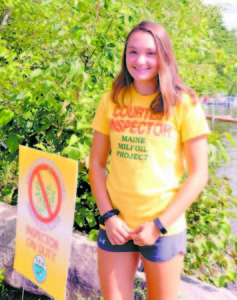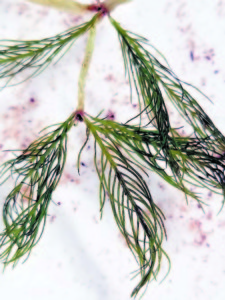‘Aware’ boat inspector makes a big save at Long Lake

GOOD CATCH — LEA boat inspector Addie Casali found invasive plants on a boat to be launched into Long Lake in Harrison in late July.
By Wayne E. Rivet
Staff Writer
Addie Casali followed her instincts and likely saved Long Lake from an invasive plant attack.
An inspector with Lakes Environmental Association for the past two summers, Addie encountered a boat from Lake Champlain on the last Saturday in July launching into Long Lake in Harrison. She knew Lake Champlain is a hot spot for invasive aquatic species
During her inspection, Addie found plants wrapped around the propeller of the boat. The long plant fragments were dried out and hard to identify but, because of the likely origin of the plant, Addie determined that she should treat it as “suspicious†and bring it to the LEA office.
“When we first received the plant at LEA, we immediately established that it was a species of milfoil. Even dried out, we could see that the plant had feathery leaves, a clear indication that it was suspicious. Upon rehydrating, we could tell that Addie had removed Eurasian milfoil from the boat,†said Mary Jewett, teacher/naturalist with LEA. “This is a highly-invasive species and we are lucky that Addie found it. Eurasian milfoil has been confirmed in only two waterbodies in Maine, and is much more aggressive than the invasive variable leaf milfoil already present in over thirty lakes and ponds.â€
This summer, LEA has seen a rash of invasive plant activity in the state. Pennesseewassee Lake had a Eurasian milfoil “save†at the beginning of the boating season, where plants were intercepted coming from a lake in New York State. A new infestation of Eurasian milfoil was discovered in July in Cobbossee Lake. On the heels of that cleanup came the discovery of European Frog Bit, an invasive lily pad never found in Maine before.
Locally, LEA has recorded seven “saves†this year. Jewett said all but the Eurasian catch were coming out of the State Park (two) or moving through the Songo River (four).
“We had only one save last year on the Songo River,†she said. “The increase of plants found at our infested sites is likely due to the time we have spent getting the Long Lake infestation in Mast Cove under control. These infestations must be monitored each year for new plant growth. If you don’t get it early, the patches will get big again. Across the state, there have been many more. I don’t have the exact number right now. I do know that Lake Arrowhead in Waterboro has already had 48 ‘saves’ this summer. I believe all of those are from boats leaving the water or boats that only boat on that lake. That public launch has the most catches by far.â€
The discovery of new infestations always brings questions about the efficacy of the program, but lake data shows that the Courtesy Boat Inspection program is working. Maine continues to have many fewer invasive aquatic species compared to other New England states. Less than 10% of Maine waterways contain invasive species compared to 84 bodies of water in neighboring New Hampshire that have invasive aquatic plants. Maine has about 40 total infested waterbodies with different plants, mostly variable milfoil, Jewett said.
LEA partners with smaller lake associations — such as Keoka Lake Association, Trickey Pond Environmental Protection Association, Peabody Pond Association, Hancock Sand Pond Association, Moose Pond Association and Woods Pond Water Quality Association — to cover more area.
“They help by paying for the hours that inspectors are there,†Jewett noted. “LEA provides training and payroll services.â€
Most locations are staffed with boat inspectors by the start of Memorial Day weekend and end after Labor Day. There are 28 inspectors, covering 14 launches on 12 lakes — Long, Highland, Sebago (state park), Crystal, Keoka, along with Sebago Cove, Trickey Pond, Moose Pond, Woods Pond, Songo River and Hancock Pond.
In LEA’s service area, boat inspectors cover five infested waterbodies. There are no public launches on Brandy Pond, so LEA doesn’t have inspectors there.
What if there is a milfoil outbreak? Cleanup can prove costly. Over the past two years, LEA has spent about $40,000 on the new Long Lake infestation.
“We get some grants from the DEP and make up the rest with donations from the community,†Jewett pointed out.
Despite the successes, the milfoil programs need help. Funding for both the inspection program and plant control is stagnating, while the required work is increasing with more boat traffic and new infestations.
“We need more launches to be covered by inspectors for longer hours. We need an increase in support as new, and old, infestations are tackled,†Jewett said.
Presently, towns contribute the following:
- $10,000 from Naples for plant control
- $1,500 from Bridgton for plant control and $2,900 for boat inspections
- $4,000 from Harrison for milfoil (LEA uses the funds for inspections since the town did not specify how the money was to be spent)
- $5,000 from Casco for plant control.
Another key to preventing new milfoil infestations is having boaters inspect their own watercraft. Maine state law already prohibits the transportation of aquatic plants on boats and trailers (MRSA Title 12, Sections 13056 and 13058), but inspectors routinely find plant fragments on boats. Inspectors are posted at boat launches as a courtesy to prevent the errant plant from entering Maine’s water, not to enforce this law.
“The new infestations show that our inspectors aren’t enough to fully protect our waters. The boater coming from Lake Champlain left Vermont and crossed two state lines before pulling up to the launch in Harrison. That single fragment of Eurasian milfoil could have caused a new infestation,†Jewett noted. “If they had decided to launch the next morning when the boat launch is not staffed, there wouldn’t have been someone there to catch it.â€
LEA encourages the boating community to take the time and look closely at one’s boat, trailer and gear for plants.
And, if you see an inspector like Addie Casali working at a launch, thank them for their hard work trying to protect an amazing resource — our lakes and ponds.


